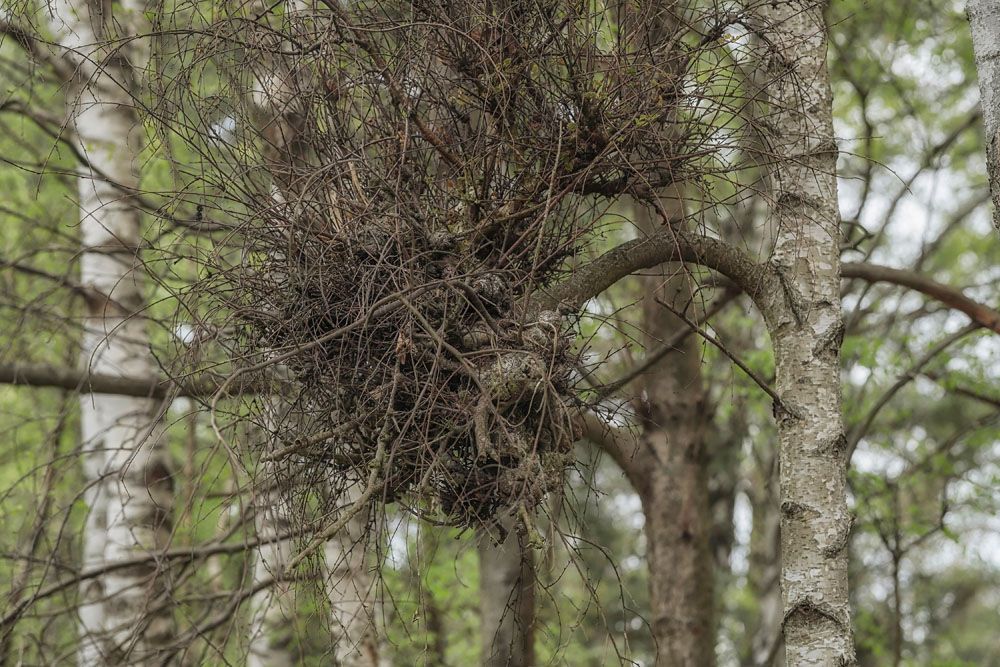
Witches Broom
Witches’ Broom
Witches’ brooms can be found on a variety of coniferous and deciduous trees. A variety of variables combine to produce many shoots with small internodes that resemble a bundle of twigs or a witch’s broom. They can also take the form of a ball-shaped dwarf plant growing in a tree. Many dwarf cultivars have come from the cultivation of these witches’ brooms in greenhouses.
How to identify witches Broom?
The thick groupings of twigs or branches that sprout from a central source, resembling a broom, are identifiable as witches’ broom. When deciduous trees or shrubs aren’t in leaf, it’s best to look for it. Pines, for example, have denser needles than needleless trees.
Life Cycle of Witches’ Broom:
Infection by fungus or phytoplasmas (a wall-less unicellular organism with an unstructured nucleus), infestation by mites or dwarf mistletoe, genetic changes, or severe climatic circumstances that destroy the terminal bud of shoots is all causes of witches’ brooms. Genetic mutations may be persistent, enabling them to be reproduced vegetatively as dwarf cultivars. Oak (caused by powdery mildew), incense cedar (induced by the rust), hackberry (caused by powdery mildew and an eriophyid mite), and rose rosette are among popular trees that generate witches’ brooms (caused by a virus). On pecan, hickory, lilac, willow walnut, honeylocust, dogwood, ash, peach, and elm, phytoplasmas produce witches’ brooms and bunch diseases. In response to dwarf mistletoe infestation, juniper, firs, hemlocks, and pines grow witches’ brooms.
Causes of Witches’ Broom:
Infections and parasites are among the causes of witches’ broom. Dwarf mistletoe, for example, is one of the causes of a witches’ broom. This parasitic plant attaches itself to the tree’s branches to share its water and nutrients. Near these mistletoe-infested branches, the witches’ broom will develop. A pest or illness isn’t necessarily to blame for witches’ broom. It can occur when the tree is stressed, such as when a limb breaks off by mistake or when trimming isn’t done correctly. Fungal diseases are more common in pine and cherry trees, although a virus almost certainly causes witches’ broom in peach and black locusts. It can also be caused by mutations in genes or environmental factors that cause the terminal buds of shoots to die. If a genetic mutation causes the witches’ broom, the tree will most likely have one cluster of twigs. A gene variant that creates witches’ broom might impact conifer trees, including pine, fir, spruce, and juniper.
Which trees are more likely to develop a witches’ Broom?
Under the right conditions, almost any tree may grow a witches broom. Witches’ broom grows abundantly amid Norway spruce and American beech in central New Jersey. Other common species that grow witches’ broom as a defence against diseases caused by pests or stressful environmental circumstances include:
plane trees (Platanus),
Willow (Salix),
walnut (Juglans),
hackberry (Celtis),
ash (Fraxinus),
honeysuckle (Lonicera),
honey locust (Gleditsia)
How to control Witches’ Broom:
The witches’ broom is not toxic to the tree—its side effect, not a pest or disease itself—so you can leave it be if you don’t intend to take care of it. If you don’t like how a witches’ broom appears in a tree, you can trim it out carefully. If you don’t clean your pruning equipment between cuts, you risk spreading illness to another region of the tree. However, if you feel that a pest or illness causes the witches’ broom, you should address the source of the problem. If the problem isn’t addressed quickly, the cluster of twigs may recur, or you may notice a more serious indication of the insect or illness.
